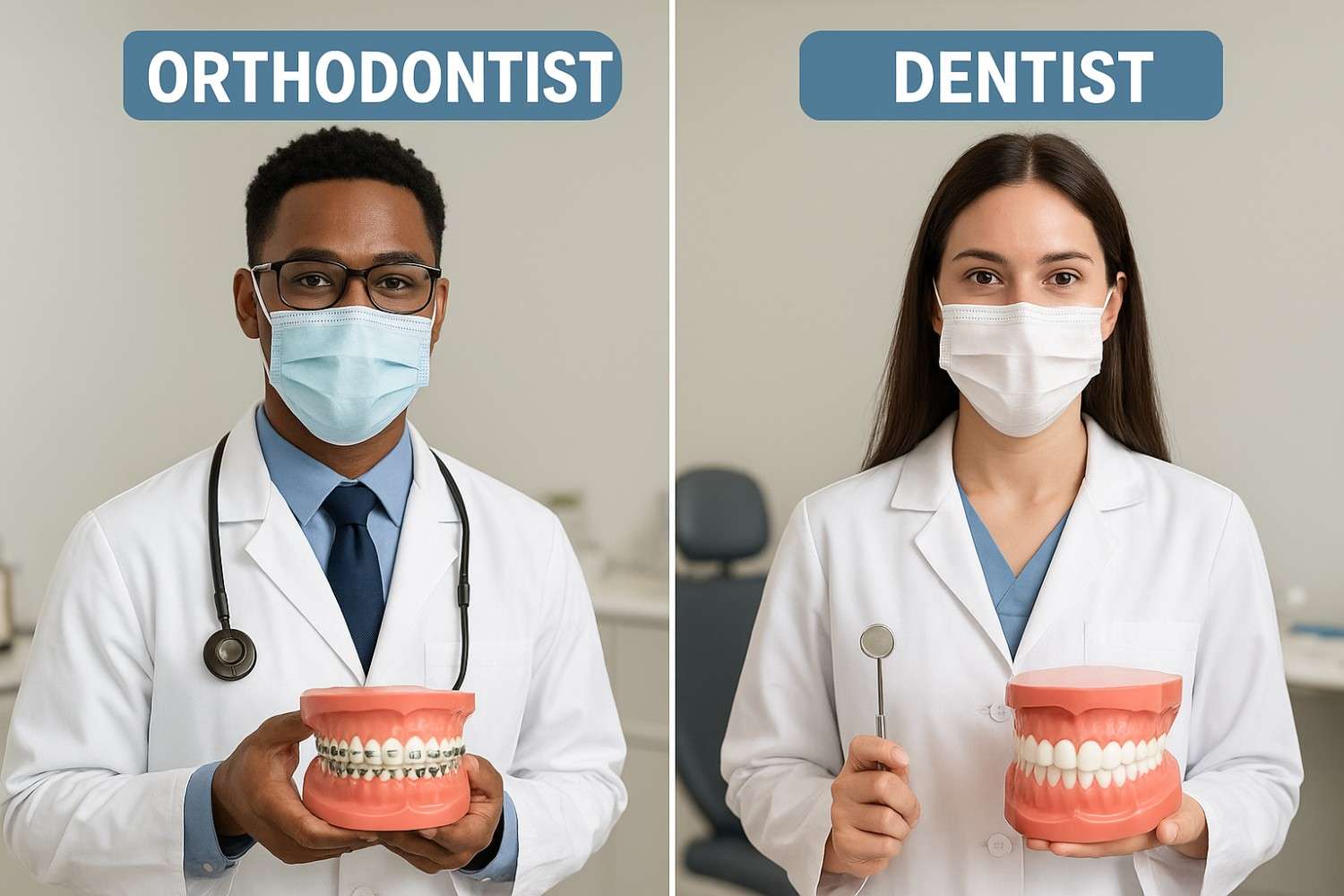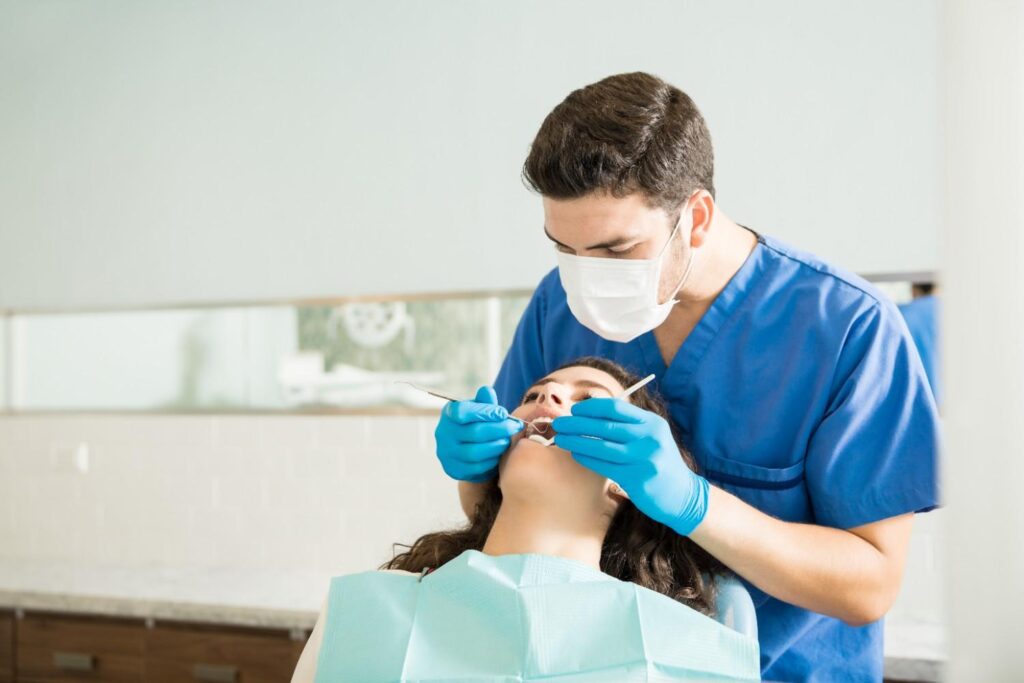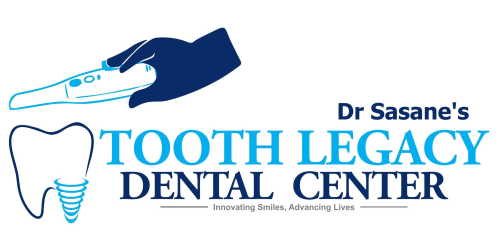
Imagine this: You’ve decided it’s time to fix your crooked smile. You schedule an appointment, only to realize you’re not sure whether to see an orthodontist or a dentist. Both work on teeth, both use similar tools, and both help improve your smile. So what’s the real difference?
You’re not alone. Many people use the terms dentist and orthodontist interchangeably, assuming they’re the same. But the truth is, while they share a foundation in dental care, their training, focus, and expertise differ significantly.
Understanding the distinction between an orthodontist and a dentist isn’t just academic, it can impact the quality, safety, and long-term success of your treatment, especially if you’re considering braces or alignment correction.
In this guide, we’ll explore the critical differences between orthodontists and dentists, including their education, scope of treatment, and when to see each one. Whether you’re researching orthodontist vs dentist for braces, curious about orthodontist vs dentist education, or simply want to make informed decisions about your oral health, this article will give you the clarity you need.
What Is a Dentist?

A dentist is a healthcare professional who focuses on the overall health of your teeth, gums, and mouth. Think of them as your primary care provider for oral health. General dentists diagnose and treat a wide range of dental issues, such as:
- Cavities and tooth decay
- Gum disease, including gingivitis and periodontitis
- Root canal therapy
- Tooth extractions
- Oral cancer screenings
- Routine cleanings and preventive care
Most people visit a general dentist every six months for check-ups and cleanings. Dentists also play a crucial role in identifying problems that may require specialist care such as misaligned teeth or bite issues and referring patients to orthodontists when needed.
What Is an Orthodontist?

An orthodontist is a dental specialist who focuses specifically on diagnosing, preventing, and correcting misaligned teeth and jaws. While every orthodontist starts as a dentist, they go on to complete additional years of advanced training to become experts in tooth movement and facial development.
Common treatments provided by orthodontists include:
- Metal, ceramic, and self-ligating braces
- Clear aligners, such as Invisalign
- Retainers and space maintainers
- Correction of overbites, underbites, and crossbites
- Early intervention for children with developing alignment issues
If you’re searching for orthodontist vs dentist for braces, the answer is straightforward: orthodontists are the specialists best equipped to handle complex alignment cases and deliver precise, long-lasting results.
Orthodontist vs Dentist: Education and Training
One of the most significant differences between an orthodontist and a dentist lies in their education and specialization.
|
DENTIST |
ORTHODONTIST |
| Completes 4 years of dental school after undergraduate studies | Completes 4 years of dental school plus 2 to 3 additional years in an accredited orthodontic residency program |
| Earns a DDS (Doctor of Dental Surgery) or DMD (Doctor of Medicine in Dentistry) degree | Receives specialized certification in orthodontics and dentofacial orthopedics |
| Trained in general oral health and a broad range of dental procedures | Focused exclusively on alignment, bite correction, and jaw development |
In essence, an orthodontist is a dentist who has chosen to specialize—much like a cardiologist is a physician who specializes in heart conditions. This advanced training enables orthodontists to design and manage complex treatment plans with a high degree of accuracy.
Orthodontist vs Dentist Treatments: What Each One Handles
Knowing which professional handles which condition can help you make smarter healthcare decisions.
See a Dentist for:
- Routine exams and professional cleanings
- Fillings, crowns, and dental bridges
- Treatment of toothaches, infections, or abscesses
- Management of gum disease
- Oral hygiene guidance
- Emergency dental care, such as a broken or knocked-out tooth
See an Orthodontist for:
- Crooked, crowded, or gapped teeth
- Overbite, underbite, open bite, or crossbite
- Jaw pain or discomfort related to misalignment
- Cosmetic alignment treatments
- Braces, clear aligners, or retainers
- Early intervention for children with developing bite issues
Many patients benefit from seeing both, a general dentist for ongoing oral health maintenance and an orthodontist for alignment correction. Coordinated care ensures your teeth are not only straight but also healthy and functional.
When Should You See an Orthodontist Instead of a Dentist?
Certain situations clearly call for an orthodontist’s specialized expertise.
- You’re Considering Braces or Clear Aligners
While some general dentists offer basic orthodontic treatments, orthodontists have advanced training in biomechanics and facial growth. This expertise leads to safer, more predictable, and longer-lasting results. - You Have a Bite or Jaw Alignment Problem
Issues like difficulty chewing, speech impediments, or temporomandibular joint (TMJ) pain often stem from jaw misalignment—conditions orthodontists are trained to diagnose and treat. - Your Child Shows Early Signs of Teeth Crowding
The American Association of Orthodontists recommends that children have their first orthodontic evaluation by age seven. Early assessment can prevent more serious problems later. - You Want a Customized, Long-Term Solution
Orthodontists use advanced tools such as 3D imaging, cephalometric analysis, and digital treatment planning to create personalized strategies that align teeth and improve facial aesthetics.
Common Misconceptions About Orthodontists and Dentists
Let’s address a few myths that often confuse patients.
- Myth: Any dentist can safely provide orthodontic treatment.
Fact: While some dentists offer braces or aligners, they lack the specialized residency training that orthodontists undergo. This can lead to suboptimal results or even harm if tooth movement is not properly managed. - Myth: Orthodontic treatment is only for children and teenagers.
Fact: Adults of any age can benefit from orthodontic care. In fact, more adults than ever are seeking treatment to improve their smile and oral function. - Myth: The cost of seeing an orthodontist isn’t worth it.
Fact: While orthodontic treatment may come at a higher price, the investment pays off in better alignment, improved oral health, and enhanced confidence, results that last a lifetime.
Why Choose a Specialist? The Bottom Line
General dentists are essential for maintaining oral health, but when it comes to correcting tooth alignment and bite issues, orthodontists are the undisputed experts. Their focused training, experience, and advanced diagnostic tools make them the ideal choice for anyone considering braces, aligners, or long-term smile transformation.
Your smile is unique, so your care should be too. Choosing the right professional ensures you receive treatment that’s not only effective but also safe and tailored to your needs.
Trust the Experts at Sasane Dental Clinic
If you’re trying to understand the difference between orthodontist and dentist or looking for trusted care in braces, alignment, or general dentistry, look no further than Sasane Dental Clinic.
Our clinic brings together highly qualified dentists and certified orthodontic specialists, offering comprehensive, patient-centered care under one roof. Whether you need a routine cleaning, a root canal, or a full orthodontic transformation with Invisalign or self-ligating braces, our team is committed to delivering exceptional results with precision and care.
At Sasane Dental Clinic, we believe that every smile deserves expert attention. We combine advanced technology with a deep understanding of dental and orthodontic science to help you achieve a healthier, straighter, and more confident smile.
Schedule your consultation today and take the first step toward the smile you’ve always wanted.
FAQs for Orthodontist vs Dentist
Q: What’s the difference between an orthodontist and a dentist?
A: A dentist handles general oral health like cleanings, fillings, and gum care. An orthodontist is a dentist who has done extra training to specialize in straightening teeth and correcting bites.
Q: Can a dentist put braces?
A: Some dentists offer basic braces or aligners, but they aren’t specialists. For the best results, especially with complex cases, it’s better to see an orthodontist.
Q: Do I need to see an orthodontist for braces?
A: Yes. Orthodontists have advanced training in tooth movement and jaw alignment. They’re the best choice for safe, effective brace treatment.
Q: How long does an orthodontist train compared to a dentist?
A: All orthodontists start with 4 years of dental school. Then they complete 2–3 more years of full-time specialty training in orthodontics. That’s thousands of extra hours focused only on alignment and bite correction.
Q: When should my child see an orthodontist?
A: The ideal age for a first check-up is 7. At this stage, early signs of crowding or jaw issues can be spotted and treated if needed.
Q: Can adults go to an orthodontist?
A: Yes. It’s never too late to fix crooked teeth or bite problems. Many adults choose clear aligners or discreet braces for a straighter smile.
Q: Do I need a referral to visit an orthodontist?
A: No. You can book directly. Some people go on their own, while others are referred by their dentist.
Q: Why choose Sasane Dental Clinic?
A: At Sasane Dental Clinic, you get expert care from both dentists and orthodontists. We offer personalized treatment, modern technology, and honest advice, all to help you achieve a healthy, confident smile.

